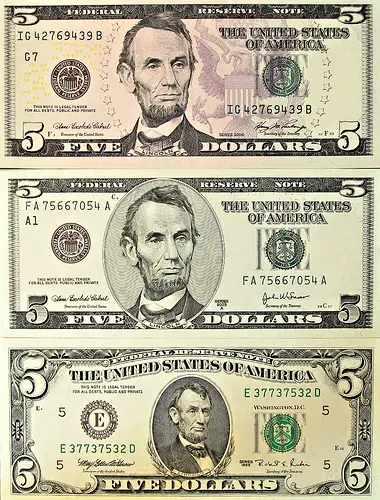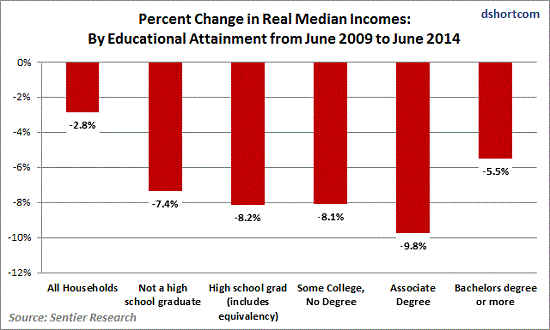From Charles Hugh Smith’s Of Two Minds blog:
 It’s starting to feel like a $5 bill is the new $1 bill. Everything that could be purchased with one or two dollars not that long ago is now $5 or even $10. A few days ago I was enjoying the Butte County Fair in California’s farm belt (the Central Valley), and it seemed like a rural county fair was a price baseline that was far enough away from the urban artifice of $100 meals at fancy bistros to reflect the statistically elusive real-world inflation.
It’s starting to feel like a $5 bill is the new $1 bill. Everything that could be purchased with one or two dollars not that long ago is now $5 or even $10. A few days ago I was enjoying the Butte County Fair in California’s farm belt (the Central Valley), and it seemed like a rural county fair was a price baseline that was far enough away from the urban artifice of $100 meals at fancy bistros to reflect the statistically elusive real-world inflation.
Everything was $5, or close to it: the carnival rides for kids: $5. The games (ring toss, etc.): $5. Funnel cakes, cotton candy, etc.: $5.
Whatever wasn’t $5 was $10: pulled pork sandwiches, etc. There was almost no need for $1 bills, except at the admission booth: adults, $8 per day; kids and seniors, $4.
So let’s add up the costs for a family of two adults and two kids. Let’s say the kids each get four rides — that’s 4 x $5 = $20 x 2 = $40. Each kid gets two food items: $5 x 2 = $10 x 2 = $20, and gets to play two games: $5 x 2 = $10 x 2 = $20. That’s $80.
The parents get something to eat and maybe play a game or two: that’s another $40. The admission fee is $16 for adults and $8 for the kids, $24. Parking is $5.
The family spends about $150 at the county fair for a day. Add an extra kid or a few other purchases and the cost pushes up to $200.
This trend of $5 being the minimum purchase price and outings costing $200 is not unique to county fairs. Some friends attended a San Francisco Giants baseball game recently. And they were delighted to buy seats online for a discounted price of $64 each. Add in $25 parking (or $20 in BART train fare) and a few $10 cups of beers and $10 hotdogs, and it costs $200 for two people to attend a major-league baseball game (at least in a desirable locale with a winning team).
Now I readily confess to being frugal. Not making much money for extended periods of time tends to encourage frugality. Frugality is also the only way most of us non-silver-spoon types can accumulate capital (savings) to invest in ourselves and our own enterprises.
Two-hundred dollars seems like a lot of money when I think of what else it can buy. Two-hundred dollars bought all of the gasoline for our 2000-mile camping trip last summer (our 1998 Honda Civic gets 40 miles to the gallon on the highway), and all of the groceries for our household for a month. (We have a garden. We also eat low on the food chain and shop almost exclusively at Costco and ethnic markets.)
Two-hundred dollars will buy a new Skil 77 worm-drive Skilsaw ($149.99). Or a new designer-label suit at a premium outlet. (After being dragged to the outlet by foreign friends awhile back, I bought an excellent Calvin Klein suit for less than $200 that will last decades.)
Meanwhile, earned income is declining when measured in purchasing power. The median household income in Butte County is about $43,000, and $54,000 nationally.
Courtesy of chartist extraordinaire Doug Short, here is a chart of the changes in median household income since June 2009:
How long can households afford $200 outings as their real (adjusted for purchasing power) incomes continue eroding?
There are no limits on the cost of government services or government-controlled sectors such as healthcare. Our city garbage service fees just jumped from $356 quarterly to $453, a 27% increase. Note to Federal Reserve: 27% is not 2%.
Our monthly healthcare insurance (paid entirely by us, as we’re self-employed) leaped $300 per month over the past few years, from $900 per month to $1200 per month. These increases add up to thousands of dollars a year. That is not 2% inflation.
Clearly, healthcare, government services, events, food purchased away from home and live entertainment are increasingly unaffordable to the bottom 90%.
***
(Note: This article was originally published on 1 September 2014.)
Photo Credit: The.Comedian


I am amazed also at how expensive things have gotten, and how “normal” they are.
We occasionally do theme parks, county fairs, meals out. And wow. We went out for breakfast and dinner once each this past month (locally). $50 for breakfast (for four), $110 for dinner. At a casual restaurant. (This doesn’t even include the amount we spent on our vacations this past month.)
Even 2 nights of camping (driving our Matrix, which only gets about 27 mpg), was $98 (state beach). I need to find cheaper places to camp.
While $200 won’t feed us for a month (probably 2 weeks), I still think about how much it WILL pay for.
The thing that shocks me is how common these activities have become. We didn’t eat out much as a child. Now I have friends who go to breakfast weekly, to dinner 2x a week with their kids, to 6 or 7 concerts a year. Our last concert was …. pre-kid …probably 20 years ago, before we married. Babysitting alone is crazy.
We have taken a few vacations to theme parks (Disney once, Legoland a few times), and the trips are pricey. So we limit how often we go. But I know families who make these trips annually or even more often.
I am amazed of how long this is i didn’t get past the fist sentence
I am amazed at how rude you are.
I can certainly relate to the increased cost (or should I say inflated price tag) of admission to the county fair. Ninety-five dollar for a family of three! Incredible! ! Count me out. I’ll stick with McDonald’s Dollar Menu, free local movies/concerts in the park or downloading free games on my cellphone.
Here’s another sign that the $1 bill is becoming less important in our everyday lives: The lifespan of a $1 bill is now actually longer than a $5 bill — and the $10 and $50 bills too!
According to the Federal Reserve’s own website:
“One factor that influences the life span of each denomination is how the denomination is used by the public. For example, $100 notes … pass between users less frequently than lower denominations that are more often used for transactions.”
Denomination (Estimated Life Span)
$1 (5.9 years)
$5 (4.9 years)
$10 (4.2 years)
$20 (7.7 years)
$50 (3.7 years)
$100 (15.0 years)
Source: Federal Reserve Bank
It’s sad that the $1 is like a cent and is perceived to be useless for some especially kids who nowadays ask for $5. There will come a time for sure that 1$ will be “useless” because of price hikes.
When I worked for a bank as a teller, the $5 bills were always the most worn (and nasty), so I can believe it.
I’m old enough to remember paying less than $1 per gallon for gas. Actually, less than 90 cents per gallon. So, in about 20 years it’s moved a lot closer to $5 territory in some areas…near $4 here. Either way, it sure has increased at a rate that outpaces increases in earnings for many people.
If you’ve been on Fiverr, you can see that all kinds of things are offered for $5. It’s eye opening, put it in terms of the level of effort to go through to afford little more than a gallon of gas.
It’s just sad that the local county fair would cost that much. Prices have gotten so bad hubby and I have been comparison shopping at the local dollar stores (btw, David’s sunflower seeds are 20% less at Dollar General than at Family Dollar! 😉 )
I wonder, how much of the sky high prices at the fair are caused by taxes, permits, and regulation fees?
It’s going to have to be something I really want or need to get me to pony up $5. My wallet is full of George Washington’s photo.